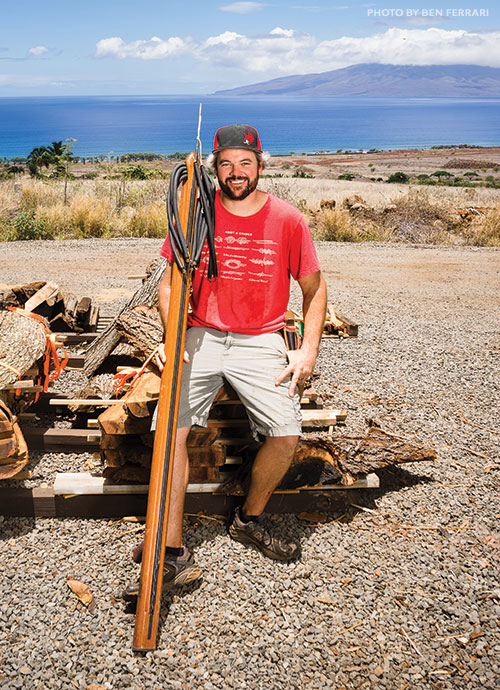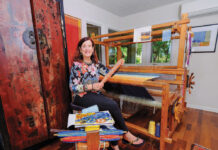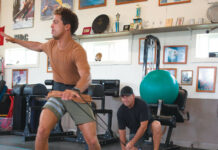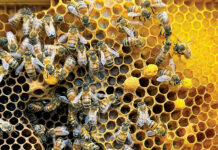Story by Kyle Ellison | Photos by Ben Ferrari

Standing in his Launiupoko woodshop, surrounded by sawdust and tools, Jake Ramey reflects on the question I’ve just asked: What’s the best part of crafting custom spearguns? Sure, there’s the creative process, and the satisfaction of making something with your hands, but he settles on something much more personal:
“I know every person who shoots my guns — and that’s kind of cool.”
Very cool, considering Ramey has shaped 150 spearguns since 2006.
“I’m able to live vicariously,” he continues, “through a lot of different people. I get pictures from around the world, and there’s a lot of pride in [knowing] that these guys are using something I built.”
Born in Po‘ipū, Kaua‘i, Ramey relocated to Maui in his senior year of high school, right about the time he began to immerse himself in hunting fish underwater. As the dives got deeper, and the fish got bigger, he began to experiment with designing his own gun, and took down a yellowfin tuna — the largest fish of his life.
Soon friends wanted him to make them one, and then friends of friends, as word of these wooden spearguns rippled through the dive community. Scouring dive forums for ideas, Ramey began making guns of Italian and Croatian design, as well as hefty tuna guns with six powerful, five-eighths-inch bands that pack 480 pounds of force.
He expanded his offerings, experimenting with teak versus koa, and fitting some guns with carbon-fiber tubes to increase their rigidity and use seawater as ballast. He recycles fishing lead he finds on the reef and uses it to balance the weight, and while most of his guns feature an image of fish such as uku (snapper), ono (mackerel), or ‘ahi (tuna), Ramey stresses function over form. “First, it has to be a good speargun, and pretty to look at second.”
Nevertheless, “another goal is to keep creating,” which is why some guns he’s built have full koa handles and eighty-inch abalone inlays, or images of ‘iwa birds that remind Ramey of “special times, riding out storms or finding big fish.” Ramey remembers walking outside in 1992, during Hurricane ‘Iniki, as the eye passed over Po‘ipū, and staring up at a patch of blue sky where “what seemed like a thousand” ‘iwa birds were circling overhead.
It’s these human touches that separate Ramey’s from a standard-production speargun.
“Spearfishing is meditative,” he says, “just being out in the water. It’s quiet and loud at the same time, and really the most archaic form of fishing—you’re in their environment.”
While Ramey isn’t there for every fish that’s caught with a Ramey Customs speargun, “I still have a personal connection to that fish, because it was hours and hours of my time. To put that in someone else’s hands, and their getting to pull the trigger, it’s pretty cool to share in that excitement.”
Find more information and photos of Jake’s spearguns and other woodwork at Ramey Customs.com and @rameycustoms.





